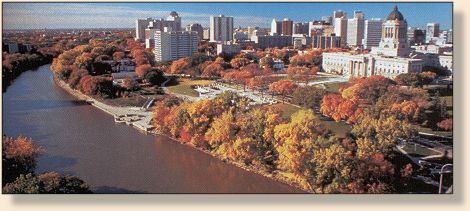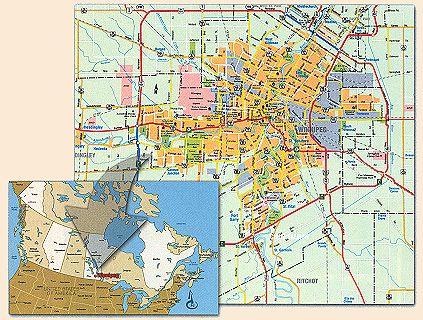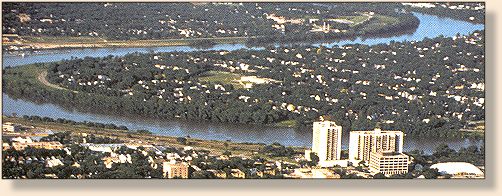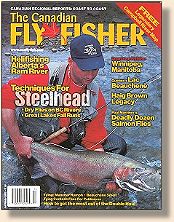The Downtown Fly Fisher
Winnipeg
By Bill Charles and Steve Abraham
We could see them from the top of the hill. Dozens
of tailing and rolling fish and, for a few minutes, we just
stood silent and watched, almost forgetting our plans for
the day, but only just. Wading out into the river, we soon
found ourselves surrounded by carp, some easily exceeding
20 pounds.
The first swing of a #10 Woolly Bugger brought a sudden
strike, but not the expected determined run, and five
minutes late, a freshwater drum came to the net. The next
dozen casts produced a small sauger. Huge carp would occasionally
drift ghost-like through the murky water within 10 feet of
where we stood. Something large brushed past my leg. I
clipped off the bugger, tied on a Hexagenia dry and cast out
toward a group of rolling fish. The fly had drifted five feet
when a broad, bronze snout appeared, the fly disappeared and
the large arbor reel started to sing my favorite song.

Sitting at the confluence of the Red and Assiniboine rivers,
the city of Winnipeg offered a veritable bouillabaisse of
opportunities for the fly fisher. The Red River alone holds
more species of fish than any other body of water in Manitoba,
and most of these readily take a properly presented fly.
Winnipeg is a city of rivers with over 100kms of navigable
waterways within the city limits. The Red is the only river
of significant size in North America that flows north from
the USA across the border to Canada. It ends its journey in
Lake Winnipeg, approximately 35 km north of the city. The
other major river is the Assiniboine which flows into Manitoba
from Saskatchewan and joins with the Red at The Forks. In
addition, two other smaller rivers also join the Red, the
Seine just north of The Forks junction and the LaSalle in
the south end of the city. In the west, Sturgeon Creek enters
the Assiniboine River. In the spring, these smaller waters
host literally thousands of carp, which enter from the main
rivers to spawn. Sturgeon Creek is also important as a
spawning area for walleye.

All these waters are significant to Winnipeg's landscape.
They provide natural breaks in the cityscape, green space
along their banks, walkways and parks for recreation and
of course many fishing opportunities for the people of the
city. Although the majority of local anglers practice bait
or spin fishing, the popularity of fly fishing is steadily
increasing, boosted by the enthusiastic promotion of the
Manitoba Fly Fishing Association. The Winnipeg-based
MFFA has been a strong advocate of effective resource
management and sound conservation practices, both within
the city and throughout the province of Manitoba.
The Red and Assiniboine Rivers
When it comes to channel catfish, the Red River is internationally
known and for good reason. It is common to see vehicles from
all over North America part in and around Lockport during prime
"cat" season. More recently, European and Australian anglers
have been attracted to the Red River fishery, not because of catfish,
but because of carp. Originally brought to North America to be
raised as a food fish, escapees quickly established themselves
in Manitoba's lakes and rivers.
The Red River fishery generates millions of dollars of tourist activity:
fishing activity of a 10-mile stretch of the Red River near Selkirk,
Manitoba, adds about $10 - $12 million annually to the local economy.
The sections of the Red River at and downstream from Lockport, and the
Assiniboine in the vicinity of Headingly and Beaudry Park are of prime
interest to fly fishers, as they provide easy wading. However, in
order to effectively fish the rivers within the city limits, a boat
is required. Because it is a large, slow-moving river, it is often
difficult to read. The best approach is to fish along the banks
containing some forms of structure. Look for cut banks, current
seams, eddies, fallen trees, overhanging vegetation, bridge pilings,
and docks.
While good sport is available within the city limits, the greatest
concentration of fish can be found at the Lockport dam and downstream
from there to Selkirk. The control dam and locks were built in 1910
to help river traffic to and from Lake Winnipeg navigate the St.
Andrews Rapids. It is a unique design that used wooden curtains to
control water levels and is the largest of this type ever constructed
and probably the last survivor in the world. The small community of
Lockport has good access to the river, a park with picnic tables, a
waterslide park, restaurants and boat launch facilities.

This is the most production section of the Red and, not surprisingly,
most Winnipeg anglers are willing to take the short drive to fish
here. On the west shoreline below the locks, the water deepens
quickly to facilitate boat traffic and is used mainly by bait
fishermen. The east shore is ideal for wading fly fishermen. The
bottom is gravel and rocks with some deeper areas around submerged
humps. There is a rock island near the dam with deeper channels on
both sides and a little farther downstream, a normally submerged
peninsula extends nearly to the middle of the river where the
bottom again drops to the deeper section. A bit farther downstream,
the Winnipeg Floodway outlet channel joins the Red with a couple of
rock islands, which can be approached from the shore by wading
during normal water levels. These areas are easy to wade and
provide access to a variety of water flows and depth. Be warned,
though, that water levels can change rather dramatically in a short
period of time.
|
While the smaller species (goldeye, mooneye, and sauger) are a
lot of fun on light outfits and floating lines, they're far
too fragile for carp and catfish. For these you need at least
a 7wt. Outfit with a large arbour, disc drag reel big enough to hold
plenty of 30 pound test backing. If you intend to fish both cats
on the bottom and carp on the surface or in shallow water, you'll
need both sinking and floating lines to match.
|
The name Winnipeg is derived from the Cree word "winnipi,"
meaning muddy or dirty water, and it certainly is an accurate description.
The silt-load carried by the Red and the Assiniboine renders them a
colour that would send most fly fishers heading for home. The
techniques and flies required to succeed in this environment have
been developed with this in mind. In short, make it flashy and
available. If you can place the fly at the proper depth, you may
very well latch into the largest fish you have ever experienced on
the end of a fly rod. Of course, landing it is another matter
altogether.
Fort Whyte Nature Centre
Once the site of a commercial quarry, the Fort Whyte Nature Centre now
contains over 200 acres of forest, lakes, wetlands and self-guiding
trails. The interpretative centre features numerous displays and
exhibits including a children's Touch Museum and the Aquarium of
the Praries. Residing within the city limits, the centre is a bird
watcher's paradise, particularly in the spring when over 200 species
take up residence or stop by as they migrate north. From late
September to mid-October, thousands of Canada Geese stop at Fort
Whyte Centre, as part of their southerly migration. During the day
they feed heavily on nearby grain fields, returning at the end of
the day to the centre's lakes. The Centre host "Sunset Goose Flights"
where you can watch in excess of 20,000 geese returning for the night.
It really is quite spectacular. Bring a hat.

Of particular interest to the fly fisher are the Centre's five lakes,
which contain everything from Northern Pike and Largemouth Bass to
Rainbows and Arctic Char. The provincial angling records for Arctic
Char and Largemouth Bass were set on Fort Whyte Centre's lakes. It's
a great place to try out new equipment and techniques. The centre
also operates a complete fishing education course that promotes
resource stewardship and angling ethics.
Next time: The fish and the flies!
Credits: This article is from the
Canadian Fly Fisher magazine. We appreciate use permission!
Our Man In Canada Archives
|



